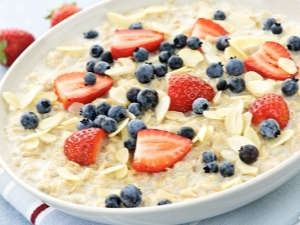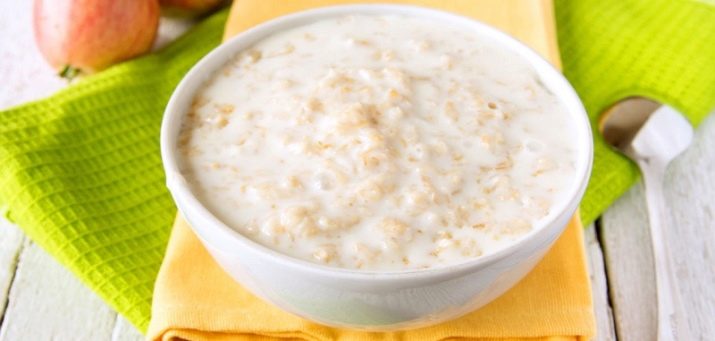Is there gluten in oatmeal, which one and how bad is it?

Oats do not apply to products containing gluten, but this protein can get into it during processing.There is a special technology for growing and processing oat grains, which allows you to avoid "infection" with gluten.
Glued Protein in Oats
Oatmeal, or "Hercules", is considered one of the most healthy cereals, it is customary to eat it for breakfast. It contains a large amount of vitamins, minerals, and fiber. Adhesive protein gives a special viscosity of oatmeal and envelops the stomach, reducing the unpleasant symptoms of gastritis and peptic ulcer. The stickiness of the cereal provide special proteins. In oats, it is avenin, which is digested by our body more easily than other proteins of this group. In rare cases, it can cause irritation of the intestines.
Gluten can get into oatmeal, flour, flakes and other foods at random during the processing of the grains. Of course, the gluten content in such products will not be as high as in bread or buns, but with gluten intolerance this can provoke a severe allergic reaction.
What it is?
Gluten is a group of water-insoluble proteins (prolamins) in the composition of grain crops. Most of this protein is found in wheat - from 30 to 80%. There is a special technology that produces gluten from the grain. It is used to thicken some products: ketchup, ice cream, yogurt, sweets, sausages. To obtain gluten, wheat flour is poured with water, the insoluble precipitate is gluten, which is used in industry.
On packages of products with the addition of gluten it can be stated that the composition contains hydrolyzed or textured vegetable protein. The more gluten in the flour, the better the dough turns out. When mixed with water, the sticky protein forms a viscous structure and allows you to get a soft elastic mass for baking. In addition to viscosity, this protein helps to preserve the freshness of the finished product longer. Gluten is in all products that are made from wheat, barley, rye: in bakery products, cakes, cereals, pasta products, beer and others. It is also added to cosmetics: lipstick, powder, cream.
Vitamin E in the composition of products, usually obtained from wheat, may also indicate gluten content.
Gluten is not able to harm the body through the skin. But the risk of getting into the body is still there, for example, with lipstick. This is important for people with sticky protein intolerance.
How much gluten is in oatmeal?
Officially, oats are not counted as gluten-containing cereals. Some experts consider it relatively safe for celiac disease (gluten allergy). Only 1% of patients do not tolerate oatmeal.
But part of the wheat protein can get into the finished oat products. Oats are grown on the same land as other grains. It is processed on the same equipment as wheat, rye, and barley. Therefore, wheat protein particles can be mixed with oat products. Its amount can reach up to 12%.
For celiac disease, you need to select products marked "gluten free." Such a mark is placed if during the cultivation and processing the contact of oats with other cereals has been completely excluded.
What harm can its use bring?
Back in the early 2000s, experts warned about gluten. He was recommended not to give children up to six months, so as not to provoke an allergy. Later it was proved that the best age for the introduction of gluten-containing feeding is 4-6 months. At the same time, the United States began to talk about the dangers of gluten for the body, and the store shelves filled the "gluten-free" products. Adhesive protein the human body perceives well. Approximately 6% of the world's population suffers from gluten intolerance, half of which do not show a complete rejection of it.
Intolerance is associated with the work of our immunity. The body perceives gluten in the body as a threat and begins to attack.The microflora and walls of the small intestine are destroyed. The consequence is poor absorption of food and nutritional deficiencies. In addition to the digestive system, joints, brain and other organs may be affected.
Gluten intolerance is expressed by bloating, diarrhea and other symptoms. Symptoms of allergies depending on age, body condition can be:
- problems with stool and fat in the stool;
- bloating and flatulence;
- weight reduction;
- dry skin, brittle nails, hair;
- joint pain;
- hives;
- dry cough.
There is a professional allergy to glutinous protein. It appears in bakery workers, as well as in people living near such industries. In infants, intolerance to the sticky protein is more pronounced. Can be added:
- an increase in the abdominal cavity on the background of weight loss;
- rash;
- nervousness or apathy;
- bad sleep
As a result, a child may have impaired metabolic processes, develop soreness, damage to organs, and rarely problems with physical development.
Healthy people who normally respond to gluten, do not need to exclude it from your diet. Bakery products contain vitamins and minerals necessary for health, and their refusal can cause vitamin deficiency and poor health.
How to get a gluten-free product?
For the production of oatmeal, flakes, gluten-free flour, the following is necessary:
- seed inspection before sowing;
- growing oats in fields where cereals have not been planted for several years;
- using clean equipment that processes only oats;
- testing of finished products for the presence of gluten.
Gluten-free oats are labeled with a special sign that ensures that the cultivation and processing of the grains took place without contact with wheat proteins. Gluten-free products are mainly made by foreign manufacturers with the label “Gluten free”. The inscription "Organic" does not guarantee that the product does not contain gluten. Manufacturers add fat to gluten-free products to keep their shape, and sugar to improve flavor. Therefore, these products are very high in calories, rich in fats and carbohydrates.
In Russia, the market for the production of gluten-free products is quite young, but the products are of high quality and good taste. On productions observe state standard specifications, do analyzes and track that there were no impurity of gluten. Some enterprises cooperate with scientific research institutes.
Among the Russian manufacturers of gluten-free products can be identified:
- Garnets;
- Dietetics;
- Pudoff;
- McMaster;
- The first combine of children's and dietary food.
The most common products without gluten are flour and flour mixtures, cereals, cereals, cereals, bread, crackers.
About what is gluten and whether it is possible to eat it, see in the next video.



























